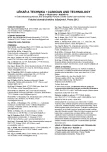-
Medical journals
- Career
Physical Activity Prescription Based on Stress Test Examination
Authors: M. Štork 1; V. Zeman 2; J. Novák 2
Authors‘ workplace: Katedra aplikované elektroniky a telekomunikací, Západočeská univerzita, Plzeň 1; Ústav tělovýchovného lékařství, Lékařská fakulta UK, Plzeň 2
Published in: Lékař a technika - Clinician and Technology No. 3, 2012, 42, 25-31
Overview
KARD training program was developed for long-term training for competitive athletes, leisure time activities and also for patients. The training program has been based on results acquired from bicycle or treadmill ergometer. Cardiopulmonary exercise testing analysis allows to diagnose of training or rehabilitation effects. On the basis of testing results the program enables selecting alternatives of long-term physical activity that optimally suits each individual. The program is able to set the type, intensity, duration and frequency of the exercise units. The physician can modify the program which is important for patients especially. On the result of the stress test cardiopulmonary examination and physician recommendation the patient can do physical activity in home, without physician supervision, e.g. only heart rate measuring is used.
Keywords:
computer program, physical activity prescription, exercise test, maximal oxygen consumption, anaerobic threshold
Sources
[1] Ainsworth B. E., Haskell W. L., Leon A. S. et al., Compendium of physical activities of energy costs of human physical activities. Med. Sci. Sports Exercise, 25 : 71-80, 1993.
[2] Goldman L. B. H., Cook F., Loscalzo A. Comparative reproducibility and validity of systems assessing cardiovascular functional class: advantages of a new specific activity scale. Circulation, 64 : 1227-1234. 1981.
[3] Hoffman N., J. Physiological Aspects of Sport Training and Performance. Human Kinetics, United Kingdom of G.B. and N.I., 2002.
[4] Janssen P. Lactate Threshold Training. Human Kinetics, United Kingdom of G.B. and N.I., 2001.
[5] Karvonen M., Kentala, K., Musta O. The effects of training heart rate: a longitudinal study. Ann. Med. Exp. Biol. Fenn. 35 : 307-315, 1957.
[6] Pollock M.L., Schmidt DH. Heart disease and rehabilitation. 3 rd ed. Champaign, Human Kinetics, 1995.
[7] Stejskal P., Hejnova J. Prescription of workload intensity in a program of continuous exercise. Med. Sport. Bohemoslovaca, 1 (4): 11-16, 1992.
[8] Stejskal P., Hejnova J. Practical problems of prescription of workload intensity of exercise programme in the field. Med. Sport. Bohemoslovaca, 2 : 76–81, 1993.
[9] Stork M., Zeman V., Novak J. Electronic system for exercise testing, evaluating and training prescription. Applied Electronics, Pilsen, University of West Bohemia, 2005.
[10] Placheta Z., Seigelová J., Štejfa M. A kol.: Zátěžová diagnostika v ambulantní a klinické praxi. Grada, Avicenum, 1999, ISBN 80-7169-271-9.
[11] Placheta Z., Seigelová J., Svačinová H., Štejfa M., Jančík J., Homolka P., Dobšák P.: Zátěžové vyšetření a pohybová léčba ve vnitřním lékařství. Masarykova univerzita v Brně, 2001. ISBN 80-210-2614-6.
[12] Chaloupka V., Elbl L. a kol.: Zátěžové metody v kardiologii, Grada, Avicenum, 2003, ISBN 80-247-0327-0.
[13] Vilikus Z., Brandejsky P., Novotny V.: Tělovýchovné lékařství, Univerzita Karlova v Praze, 2004, ISBN 80-246-0821-9.
Labels
Biomedicine
Article was published inThe Clinician and Technology Journal

2012 Issue 3-
All articles in this issue
- Physical Activity Prescription Based on Stress Test Examination
- ECMO ambulance and advanced emergency medical system
- Measurement of thermal symmetry of the human spine by the use of medical thermography
- Determination of Human Gait Phase by Zero-moment Point
- Leksell gamma knife past, present and future
- The Clinician and Technology Journal
- Journal archive
- Current issue
- Online only
- About the journal
Most read in this issue- Leksell gamma knife past, present and future
- Physical Activity Prescription Based on Stress Test Examination
- Measurement of thermal symmetry of the human spine by the use of medical thermography
- ECMO ambulance and advanced emergency medical system
Login#ADS_BOTTOM_SCRIPTS#Forgotten passwordEnter the email address that you registered with. We will send you instructions on how to set a new password.
- Career

